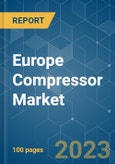The market was negatively impacted by COVID-19 in 2020. However, the market has now reached pre-pandemic levels.
Key Highlights
- Over the long term, factors such as increasing demand for compressors from the chemical industry for application such as refrigeration is likely to drive the Europe compressor market.
- However, increasing the installation of renewable energy sources to provide power that does not use compressors is expected to restrain the Europe compressor market.
- Nevertheless, new technologies in compressors with higher efficiency than the present ones that save 20-50% more energy are expected to create several opportunities for the European compressor market in the future.
- Russia, due to its highest oil and gas refining capacity in the region, is expected to dominate the Europe compressor market. As of 2021, more than 30% of the total refining capacity in Europe was in Russia, where compressors are required for several purposes, such as transportation and LNG conversion of gas.
Europe Compressor Market Trends
Oil and Gas Industry Segment Expected to Dominate the Market
- Compressors are mechanical devices that increase the pressure of a gas by reducing its volume. They are widely used throughout the oil and gas industry. The oil and gas business's upstream, midstream, and downstream sectors require compression for numerous applications, such as transmission, storage, gas gathering, gas lift, gas injection, flash gas compression, and refrigeration.
- Several countries in Europe have targeted to phase out coal-based energy due to rising environmental concerns. Such a decision is likely to trigger more gas-based power in the country, which provides a cleaner energy source than coal.
- In 2021, the total liquefied natural gas (LNG) export from the region was 3.8 billion cubic meters (bcm). The conversion of the LNG from gas is likely to use compressors, and the increase in the LNG exports from the region is expected to positively impact the compressor market in the region.
- In February 2022, British oil and gas company BP PLC signed a joint development agreement with Hydrogen Chemistry Company (HyCC) to further develop H2-Fifty, a 250MW green hydrogen plant, in the port area of Rotterdam, Netherlands. The compressor plays a crucial role in hydrogen generation by increasing the pressure of hydrogen by reducing its volume resulting in compressed hydrogen.
- Moreover, in June 2022, Neste Oyj took a financial investment decision (FID) on USD 2 billion Rotterdam refinery expansion project in Finland. The project will help the Finnish oil refining and marketing company in growing the renewable products production capacity of its Dutch refinery from 1.4 million tons per annum of renewable products to 2.7 million tons per annum.
- Hence, owing to the above-mentioned points, the oil and gas industry segment is likely going to dominate the European compressor market during the forecast period.
Russia Expected to Dominate the Market
- In Russia, energy is an essential part of the country's economy, contributing to approximately 40% of state revenues. Furthermore, Russia is projected to remain among the top energy exporters in 2021 and beyond; because of this, it is likely to be the largest market for compressors in Europe.
- Food production and processing represent a crucial part of the Russian economy. The fast pace of life in the country, easy storage, and increased shelf life of packaged foods have led to an increased demand for products suitable for consumption on the go.
- Moreover, the growth in the share of natural gas in power generation is driven by low natural gas prices and an increasing number of such plants, which is likely going to drive the compressor market.
- In recent years the country is witnessing a sharp rise in LNG exports. With the increasing expansion into the world's LNG market, the country is expected to invest in the LNG industry infrastructure, which is likely to directly impact the compressor market.
- In 2021, the gas production in Russia was 701.7 billion cubic meters (bcm), which was higher than the production in 2020, 637.3 bcm. The country has already started reducing coal usage for energy generation and compensating it with natural gas, which is likely to drive the compressor market in the country.
- In August 2022, SIBUR, a Russian petrochemicals company, announced its plan to revise its strategy for developing the Amur Gas Chemical Complex (AGCC) with Sinopec. Also, Amur Gas Chemical Complex is set to be one of the world's largest polymer production facilities. Upon completion, the project will have a capacity of 2.3 MMtpy of polyethylene and 400 ktpy of polypropylene. The facility is to be located near Svobodny town in the Amur Region, close to the Russian-Chinese border.
- Hence, owing to the above-mentioned points, Russia is expected to dominate the Europe compressor market during the forecast period.
Europe Compressor Industry Overview
The European compressor market is moderately fragmented. Some of the key players in this market (in no particular order) include Atlas Copco AB, Siemens AG, Sulzer AG, Baker Hughes Co., and Aerzener Maschinenfabrik GmbH.Additional Benefits:
- The market estimate (ME) sheet in Excel format
- 3 months of analyst support
This product will be delivered within 2 business days.
Table of Contents
Companies Mentioned (Partial List)
A selection of companies mentioned in this report includes, but is not limited to:
- Siemens AG
- Baker Hughes Co.
- Trane Technologies PLC
- Atlas Copco AB
- Burckhardt Compression Holding AG
- General Electric Company
- Aerzener Maschinenfabrik GmbH
- Sulzer AG








